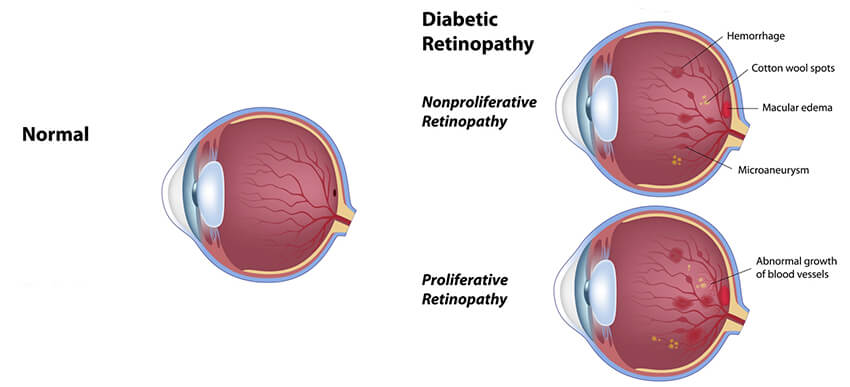Indianapolis Diabetes Treatment Options
Diabetes Mellitus
Diabetes mellitus is a disease in which your body does not use or store dietary sugar properly. Diabetes causes increased sugar (glucose) levels in the blood, and the increased blood sugar levels can damage many of the body’s vital organs: kidneys, brain, heart, eyes, and other areas.
Diabetes may lead to fluctuations in vision as well as lead to early cataracts. The most severe problem, however, is damage to the blood vessels in the retina. The retina is the sensitive light-receiving nerve tissue in the back of the eyes. The retina is like the film in a camera, and a damaged retina can cause blindness.
Diabetic Retinopathy
Diabetic retinopathy is diabetic-related damage to the retina. The retina is the light-sensitive tissue that lines the inside of our eyes. Damaged retinal blood vessels leak serum and blood and may also stimulate the growth of abnormal blood vessels on the surface of the retina. Bleeding and leakage into the retina causing blurred vision. Diabetic retinopathy is the leading cause of blindness in adults younger than 65 years. The risk of diabetic retinopathy increases with the duration of disease as well as improper control of glucose, blood pressure, and cholesterol. Smoking is a severe cause of problems as well.

What are the Symptoms of Diabetic Retinopathy?
Initially, there may be NO symptoms of diabetic eye disease. For this reason, diabetic individuals need to have a complete dilated eye exam AT LEAST once a year to check for disease. As the disease progresses symptoms may include:
- Blurred vision due to bleeding and swelling in the retina
- Seeing dark or red floaters due to bleeding
- Distortion of images
What are the Stages of Diabetic Retinopathy?
- Non-proliferative retinopathy is the earliest stage and is marked by leaking of serum or blood into the retina. Yellowish deposits, called exudates, and blood cause blurred vision, they leak into the macular region and cause macular edema. Patients with macular edema have blurred central vision.
- Proliferative retinopathy involves the formation of new, abnormally fragile vessels. This process of new vessel growth is called neovascularization. The new vessels may break and bleed very easily, releasing blood into the vitreous, a clear gel in the center of the eye. Blood that’s collected in the vitreous fluid is called a vitreous hemorrhage and causes immediate loss of vision.
Greenwood Diabetic Retinopathy Treatment
In the early stages of diabetic eye disease, no treatment may be needed. However, it is still important to have a yearly eye exam to monitor the progress of the condition. If macular edema is at risk of developing or has already developed, your doctor will recommend laser treatments to reduce the retinal edema.
If neovascularization is at risk of developing or has already developed therapy is required to attempt to shrink these fragile blood vessels and decrease the risk of bleeding into the vitreous.
Steroids and other medications may be injected into the eye to decrease the swelling within the eye. Alternatively, medicines that retard the growth of abnormal blood vessels may be used to treat neovascularization.
Finally, in situations where severe bleeding has occurred into the vitreous and has not cleared on its own, a vitrectomy may be done to remove the blood and vitreous material and replace it with a clear liquid. This can restore vision in many cases.




